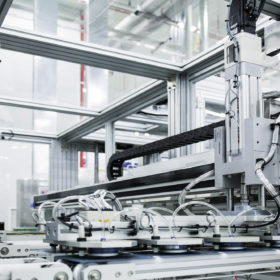
The 300,000 sq ft factory in Dalton, Georgia has the capacity to produce 12,000 PV modules per day – 1.7 GW worth annually for panels able to produce the same peak generating capacity as the Hoover Dam.
From pv magazine USA.
Friday was a big day for U.S. module manufacturing. Hanwha Q-Cells – the Korean PV maker which acquired Germany’s Q-Cells seven years ago – officially opened the biggest solar panel factory in the Western Hemisphere, with 300,000 sq ft of floorspace and 650 workers.
The fab has actually been churning out modules for months and Friday was the ribbon cutting ceremony attended by officials from Korea along with Georgia governor Brian Kemp (Republican) and even a token presence from the Trump administration. Every solar factory must go through a lengthy process of equipment testing and calibration before being steadily ramped to full production volume.
Hanwha Q Cells executives reported the factory began production in January and started shipments in February, and that all three production lines are currently running. “The factory is currently producing over 10,000 modules per day and very close to the full 12,000-module-per-day capacity,” director of strategy and market intelligence Scott Moskowitz told pv magazine. “We expect to be running at full capacity by the end of the year.”
The facility will make modules featuring 120 half-cut mono-PERC cells in the company’s Q.Peak Duo Blk-G6 line. With six busbars, around 19% efficiency and output of 330-345 W, that’s not bad for what would be a 60-cell module in full-cell terms.

The output is being sold into rooftop and large scale solar markets. While 72-cell modules are more popular for large PV plants, Facebook’s new data center in Georgia is among the ground-mount projects that will feature panels produced at the Hanwha fab.
Trump, tariffs and taxes
Clean energy research company Greentech Media cast the new factory as a win for Trump’s trade policies, but the claim is nuanced. Four large solar factories are either under construction, ramping or have already opened in the United States since the president imposed his Section 201 tariffs: Hanwha’s new 1.7 GW facility, LG’s 500 MW factory in Alabama, Jinko Solar’s 400 MW fab in Florida, and First Solar’s 1.2 GW production line in Lake Township, Ohio – which is currently under construction.
It’s a safe bet to say those facilities would not have happened without Section 201 tariffs on solar imports giving a relative edge to U.S. products. However, as every one of those companies has told pv magazine, they would also probably not have happened without changes to the U.S. tax code under tax reform rammed through by Republican majorities in Congress in late 2017.
Also, while those factories and smaller facilities that have held firm or restarted boast total annual module production capacity of around 5 GW, the United States is expected to install more than 12 GW of solar generation capacity this year.
Add to that the fact the U.S. has no cell manufacturing industry – all the crystalline silicon factories that have recently ramped up import cells – and the administration’s claim to have struck a blow for domestic solar can ring a little hollow. In fact, the one big integrated cell and module factory in the United States – the Tesla/Panasonic Gigafactory in upstate New York – does not appear to be producing much.
As such, the minor revival of U.S module manufacturing the recent factories represent does not change the fundamental nature of trade flows nor solar manufacturing. The United States still overwhelmingly installs imported solar products, mostly from Asia.
Lắp đặt điện mặt trời Khải Minh Tech
https://ift.tt/2X7bF6x
0906633505
info.khaiminhtech@gmail.com
80/39 Trần Quang Diệu, Phường 14, Quận 3
Lắp đặt điện mặt trời Khải Minh Tech
https://ift.tt/2ZH4TRU
Không có nhận xét nào:
Đăng nhận xét